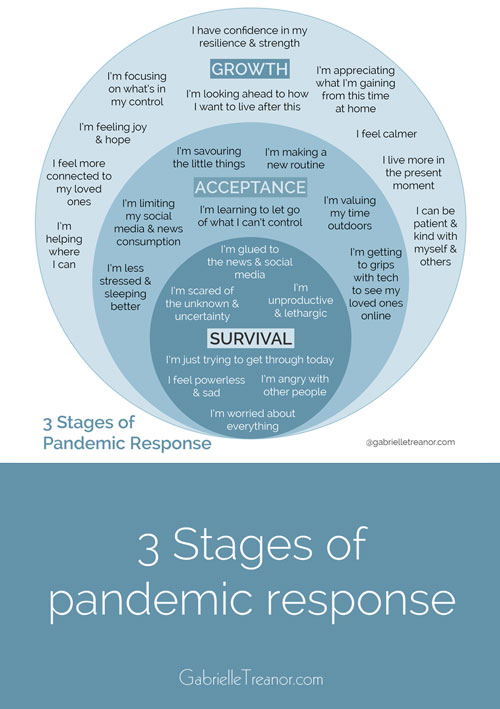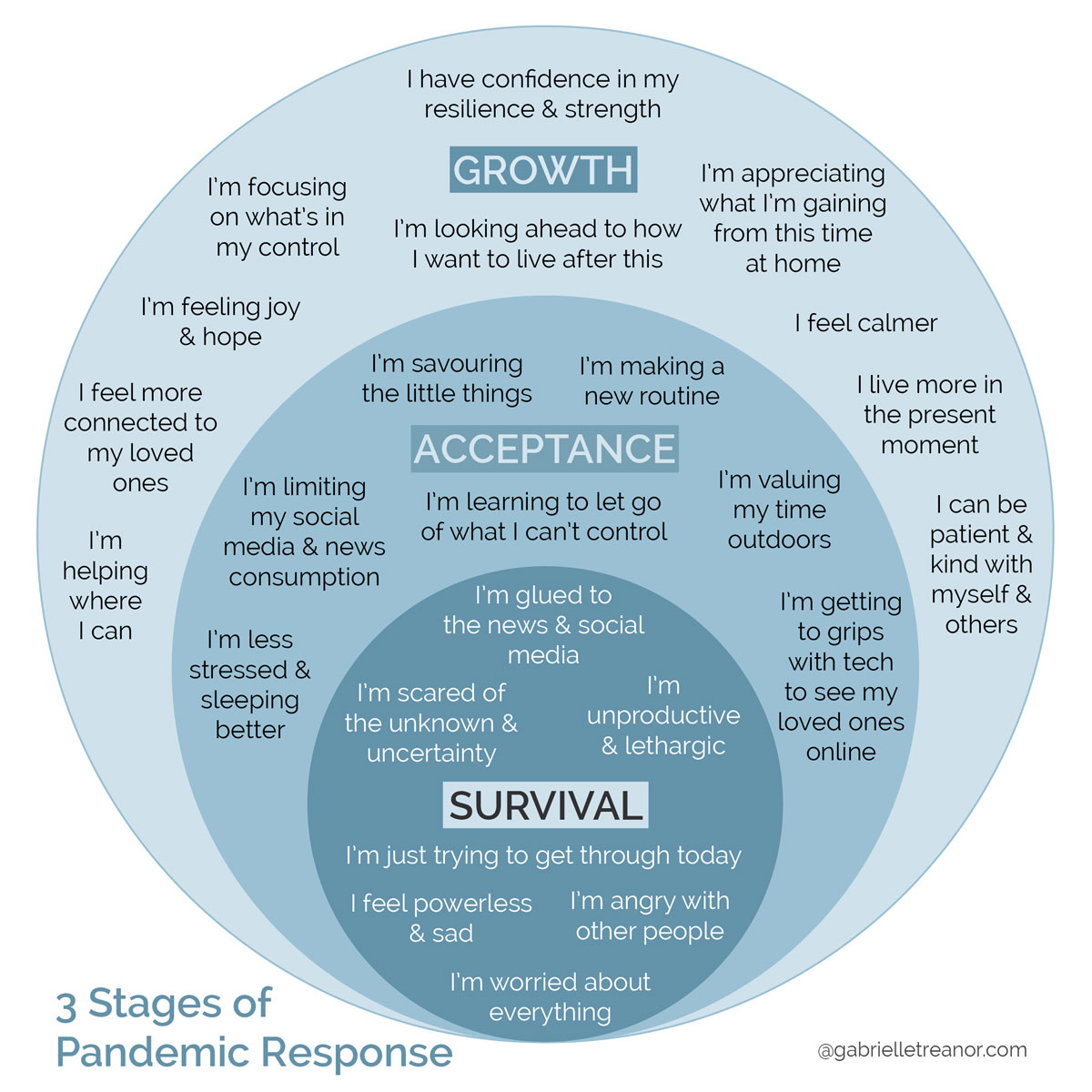3 Stages of pandemic response
3 Stages of pandemic response
I've been listening and paying attention to what people are doing, how they're feeling, the language they're using.
I was getting a picture in my head (which was being backed up by what I was hearing and reading) of three stages of thoughts, feelings and actions that people are moving in and out of as they experience this unusual time.

The first stage is Survival. You feel overwhelmed by the changes, the uncertainty, the news, yours and others' feelings.
You're trying to make it through each day, you're angry with other people's behaviour, you're frequently checking the news and scrolling social media. You find it hard to think about anything else, you feel powerless, you're lethargic, unproductive and it's affecting your sleep. Many of the symptoms of grief are tied up in this Survival stage.
Then there's Acceptance. You don't like what's happening but you're not railing against the situation so much, you've realised it helps to check in with the news and social media less often and you're creating a new routine in this current normal.
You're feeling a bit more able to let go of what's not in your control, you're noticing the little things that make you smile and you're getting the hang of chatting with your loved ones on a screen.
You're counting the days since life radically changed and longing for life to get back to normal but you're making do for the moment.
Any bells ringing yet?
And then we have the Growth stage. Here you're starting to look ahead to what you want life to be like after this is over. You're getting a sense of what you don't want to go back to, what parts of 'normal' life weren't actually working for you and that there's an opportunity here to make changes.
You're savouring the present more rather than worrying about the past or future, you're feeling a burgeoning hope and you feel more connected to the people who really matter to you.
While you are fully aware of the severity of the situation and appreciate how difficult life is for so many, your eyes are opening to what you may have taken for granted in the past and how you want to live going forwards.
To illustrate this more clearly (and who doesn't love a spot of colour coding?) I made a diagram to show the three stages:
(If you share the diagram (and you're welcome to) please be sure to credit gabrielletreanor.com and link back to me, thank you.)

Can you recognise which stage you're in today?
Here's the thing: You're going to move around the stages, in and out of them, back and forth, depending on many factors. This is an evolving process, you're adapting and changing just as the situation is.
And none of it is wrong. How you're feeling is not wrong.
Spending time in one stage more than another isn't a reflection on who you are or your ability to deal with what's happening. It's simply an aid to help you to understand what's going on in your head and heart. And, with that knowledge, look at what will help you.
In Survival it could look like giving yourself a break and allowing yourself to just get through the day.
In Acceptance it could mean looking for others to talk with, share what you're thinking and feeling, find new ways of dealing with the challenges and be inspired to look for and explore the potential and possibilities that lie within this time.
And if you're spending (or wanting to spend) more time in the Growth stage it could mean looking at what will help you with the changes that you're feeling called to make. What support will empower you to go through and emerge from this time more confident that you can and will live your life in a way that feels true to yourself.
Again, what support feels right for you is up to you.
Empowering women to make changes (big and small), to strengthen their confidence and trust in themselves, to live their lives the way they truly want to (rather than how they think they're supposed to) is the essence of my coaching, whatever the world circumstances are.
So if this feels like something you want to explore more, perhaps you have the time you haven't had before when you've been caught up in the work/life whirlwind, send me a message and we can have a chat to see if coaching is right for you. You can find out more about coaching with me here.
More than anything I want you to know that whichever stage you're in and however you're feeling that you're okay, and you will be okay.
Just as in 'ordinary' life where we each respond, act and feel differently, where we each have different needs, the same applies in these extraordinary circumstances.
Please note: If you share the diagram (and you're welcome to) please be sure to credit gabrielletreanor.com and link back to me, thank you.

Hi Gabriele
My name is Marc Smith and I’m the QHSE Manager for Mitie on a Telecommunication contract; one of my main areas of focus at present is the mental health of my team, some 200 employees who are working either as front line engineers or as support staff, each area carries its own mental health asks and it is a huge concern for me. I would just like to say that I think the phases you have put together is excellent and thank you for taking the time to share.
Mental health has always been a priority for me, my approach to mental health has very much been shaped by my experiences in the Armed Forces and also the challenges we have faced with my son Callum who has Down Syndrome.
Thank you again for this Gabrielle and I hope that you are managing to say healthy during the current restrictions.
Kind Regards
Marc
Hi Gabrielle
I really like this. I work for a city council and am currently managing a local response hub to support people affected by Covid19. This is a great tool for my team to use for thinking about their own helath and wellbeing.
All the best
Paul
Hi Gabrielle
This is a very positive view and a little mono-directional.
I guess those I know have a wider range of emotions in the acceptance and growth stages. Some are struggling with missing loved ones, some are very weary from using unfamiliar technologies to maintain work output and some are exhausted from juggling and home schooling. Others are grieving lost ones or getting more scared as they hear of friends dying. These emotions are not in the model so maybe they could be added in? It is a multi-dimensional experience.
Thanks for your comment, Julia. I agree, this is very much a multi-dimensional experience unique to each of us. The diagram is a broad overview, it doesn’t cover every possible thought or feeling that anyone may have and with it I’m not attempting to deal with every nuance that a person may experience. I agree that there are many, many different challenges and each of us is experiencing the impact of the pandemic in our own way. I would love to be able to fit in every emotion and experience to the diagram but it isn’t possible to squeeze them all into the space!
This is great. It would apply to any type of crisis response. Is it all your own, or is it linked to another model?
Thanks, Allan. I created this from listening to what the women I talk with in my work and the comments and posts I saw them writing on social media. Since releasing it I’ve had people share that it also relates to the change model.
Thank you for sharing this conceptual framework which I find very useful. I hope you can reply to me privately so I can share another version in French… I had shared it with a group of people in Senegal but didn’t know the source and want to make sure I reference the author/s properly. I work for a United Nations agency and would like to share this with some of my colleagues providing psychosocial support to our staff. Looking forward to hearing from you, and thanks again!
Thanks Gabrielle:
I work with a number of Early Childhood programs and am using this material with parents and staff who are all trying to navigate through these strange times. We are all trying to figure out what our “New Normal” is going to look like and this really helps. At the end of the day, as Brene Browne, LMSW says, our “old normal” really wasn’t that normal. “We are being given the opportunity to stitch a new garment. One that fits all of humanity and nature.” Once again, ‘Thank You’ for your generosity of spirit.
Thanks, Yolanda, it’s great to hear that you’re finding the diagram helpful in your work. Brené Brown never fails us with her wise words 🙂
Hello Emily,
I wanted to say how much I have enjoyed reading about your 3 Stages of Pandemic Response. It has been very useful to me and many of the colleagues I work with.
I wanted to ask if you intend developing and positioning this model further as we transition into a time of increasing freedom of pandemic restrictions? I would really like to continue using this model as we embrace ‘new stages of normal.’
Thanks, David, great to hear you’ve found it useful. I don’t plan to develop the diagram any further right now.
I have adapted this and made a children’s version aimed at children going back into schools. Please leave a reply if you would like me to send it to you!
Thanks, Danielle, it would be great to see the children’s version you’ve made 🙂
Dear Gabrielle Treanor,
I am Dr Pham Ngoc Thanh, Psychology Consultant at the Oxford University Clinical Research Unit (OUCRU-Vietnam) working in the mental health of health staff and patients at a hospital of Tropical Diseases, Ho Chi Minh city, Vietnam.
I am very impressed of your diagram about 3 stages of pandemic response. I know this diagram when I participated a free online training course about “Social care during Covid-19:coping with Self-Isolation and Social Distancing “ at FutureLearn.com
I would like to ask your authorization to share this diagram with my colleagues in healthcare on our OUCRU website.
Thanks so much for asking, you’re very welcome to share it.
Hi Gabrielle,
I really like your assessment and visualisation and have noticed how widely it is being used.
I wonder if as the pandemic continues to dominate the way in which much of our lives are lived and we move toward a medium term future knowing that it will not be going away there is another set of emergent responses. I am hearing more that is somewhere between growth and acceptance more a sort of resignation. There is not the positive tone of growth nor the evolutionary sense of acceptance. These appears as ‘I’m understanding what life will have to be like’ ‘I’m am making trade offs between working more and having security’ ‘I am finding ways to maintain my strength and resilience for the long term’ I think a revision that worked through some of this could be very helpful as we head into winter and inevitably a second year.